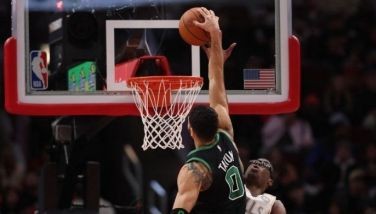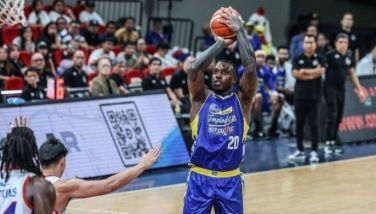Hoya a beaten man before opening bell
There’s a saying in boxing, “Train hard, and you’ll have an easy fight.” I guess this goes for other endeavors: “Study hard, so you’ll have an easy exam.”
I heard Manny Pacquiao utter these words which could have very well come from written reminders in walls of boxing gyms to fighters to train hard...and smart. Pacquiao uttered these words of wisdom right after his successful second fight with Erik Morales.
And these words aptly describe Pacquiao who, as I stressed in last week’s column, trains like a man possessed. In fact, Pacquiao is sometimes cautioned not to overdo the training or overextend himself.
I had mentioned in that column of Dec. 2 that conditioning would be one of the key factors in the so-called Dream Match. I had said that “definitely, losing 13 pounds in about nine to 10 weeks, after being used to a walking weight of more than 160 pounds for years, will take its toll physically, emotionally and psychologically. The effects of shedding weight will therefore be one of the main factors working against De la Hoya. At 35, De la Hoya is not exactly a spring chicken who can readily take on the demands of a rigorous weight reduction program.”
While De la Hoya and his camp still have to pinpoint the weight reduction regimen as one of the culprits, the comments of Bob Arum and Freddie Roach are particularly instructive.
On the night of the Friday official weigh-in, The STAR’s Abac Cordero quoted Arum, “I’ve never seen him (De la Hoya) look so drawn.” Cordero reported that Arum “keeps guessing” how the 5-foot-10 Olympic champion can cope with the hard-hitting Pacquiao.
Roach, for his part was quoted, again by Cordero, “Oscar didn’t disappoint me but I had a feeling this might happen because when he weighed only two pounds less after the weigh-in, I said after three rounds, he’d be done. He’s gonna fade quickly. De la Hoya made weight for the fight but he didn’t get ready for the fight.”
Roach was right. De la Hoya made the weight to avoid paying the $3 million fine for every pound over 147 pounds. The much-publicized scientific training regimen of De la Hoya could not do anything to restore the mobility and strength he needed to counteract Pacquiao’s power and speed.
Not to take anything from Pacquiao who trained and fought hard and smart, I tend to think that the fight was over long before it started.
The end for Oscar de la Hoya came when he agreed to fight Pacquiao at 147 pounds. Lured by his share of approximately $22 million, De la Hoya was banking on clever marketing hype to conceal the tremendous challenge he faced in going down to 147 pounds.
De la Hoya also probably underestimated the difficulty a 35-year-old fighter like him who has fought only once this year would encounter in making the 147-pound limit. The Mexican-American from East Los Angeles also brushed aside the fact that he hadn’t weighed 147 pounds in seven and a half years having fought at super welterweight and middleweight all that time. Totally cast aside too, as the glitter of money came into view, was the fact that De la Hoya hadn’t really won a big fight over the last six years, although I thought he won against Floyd Mayweather Jr.
To be sure, many fighters have answered the come back challenge despite weight, age and inactivity problems. Many have not been successful. Muhammad Ali bragged about his preparations for his comeback fight against former sparring mate Larry Holmes. But the former gave up on his stool too.
Pacquiao himself has experienced the pain of going up the ring almost dehydrated. One can therefore understand his preference to fight at 140 pounds since he has been known to balloon to as high as 150 when he was campaigning in the 126-pound division. He knows how his strength can be sapped in trying to make the weight limit.
He lost his World Boxing Council flyweight title on Sept. 17, 1999 via third round TKO to Medgoen Singurat of Thailand. He climbed up the ring despite a vain attempt to make the weight and paid dearly for it.
De la Hoya can redeem himself, but at 160 pounds or higher. One of his business partners, Bernard Hopkins, was 43 when he fought Kelly Pavlik, 17 years his senior. The two however fought at Hopkins weight division with Pavlik going up several pounds. De la Hoya would however have to focus more on boxing and leave the business part of his activities to partners Hopkins and Shane Mosley.
- Latest
- Trending




























